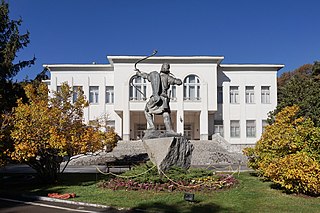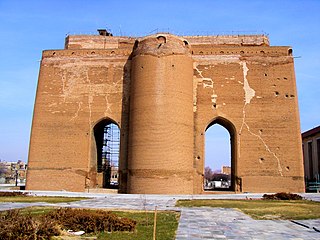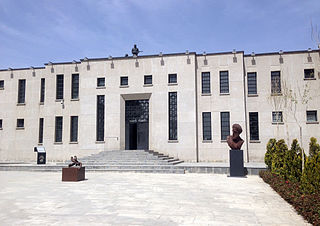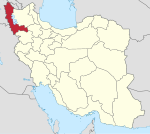
The Topkapı Palace, or the Seraglio, is a large museum and library in the east of the Fatih district of Istanbul in Turkey. From the 1460s to the completion of Dolmabahçe Palace in 1856, it served as the administrative center of the Ottoman Empire, and was the main residence of its sultans.

The Golestan Palace, also transliterated as the Gulistan Palace and sometimes translated as the Rose Garden Palace from Persian language, was built in the 16th century, renovated in the 18th century and finally rebuilt in 1865. It is the former official royal Qajar complex in Tehran.

The Sa'dabad Complex is a 110 hectare complex built by the Qajar and Pahlavi monarchs, located in Shemiran, Greater Tehran, Iran. Today, the official residence of the President of Iran is located adjacent to the complex.

A talar or talaar is a type of porch or hall in Iranian architecture. It generally refers to a porch fronting a building, supported by columns, and open on one or three sides. The term is also applied more widely to denote a throne hall or audience hall with some of these features.

Iranian architecture or Persian architecture is the architecture of Iran and parts of the rest of West Asia, the Caucasus and Central Asia. Its history dates back to at least 5,000 BC with characteristic examples distributed over a vast area from Turkey and Iraq to Uzbekistan and Tajikistan, and from the Caucasus to Zanzibar. Persian buildings vary greatly in scale and function, from vernacular architecture to monumental complexes. In addition to historic gates, palaces, and mosques, the rapid growth of cities such as the capital Tehran has brought about a wave of demolition and new construction.

Arg of Tabriz, is the remnants of a large acropolis fortification and city wall in downtown Tabriz, Iran. Its structure is visible from far distances in downtown Tabriz, if not blocked by the newly erected highrise buildings.

A riad or riyad is a type of garden courtyard historically associated with house and palace architecture in the Maghreb and al-Andalus. Its classic form is a rectangular garden divided into four quadrants by two paved paths intersecting in the center, where a fountain is typically situated. The planted areas are usually sunken below the level of the paths. Its origin is generally attributed to traditional Persian gardens whose influence spread during the Islamic period. The term "riad" is nowadays often used in Morocco to refer to a hotel or guesthouse-style accommodation with shared common areas and private rooms, often within a restored traditional mansion.

Maku is a city in the Central District of Maku County, West Azerbaijan province, Iran, serving as capital of both the county and the district.

El Badi Palace or Badi' Palace is a ruined palace located in Marrakesh, Morocco. It was commissioned by the sultan Ahmad al-Mansur of the Saadian dynasty a few months after his accession in 1578, with construction and embellishment continuing throughout most of his reign. The palace, decorated with materials imported from numerous countries ranging from Italy to Mali, was used for receptions and designed to showcase the Sultan's wealth and power. It was one part of a larger Saadian palace complex occupying the Kasbah district of Marrakesh.

Qajar art was the architecture, paintings, and other art forms produced under the Qajar dynasty, which lasted from 1781 to 1925 in Iran (Persia).

Afif-Abad Garden, originally the Gulshan Garden, is a museum complex in Shiraz, Iran.

The Museum of the Qasr Prison is a historical complex in Tehran, Iran.

The Imam Reza shrine, located in Mashhad, Iran, is an Islamic shrine containing the remains of Ali al-Rida, the eighth Imam of Shia Islam. It is the largest mosque in the world by area. Also contained within the complex are the Goharshad Mosque, a museum, a library, four seminaries, a cemetery, the Razavi University of Islamic Sciences, and other buildings.

Ferdows Garden is a historical complex located in the district of Tajrish in Shemiran, Iran.

The Shah Nematollah Vali Shrine is a historical complex, located in Mahan, Iran, which contains the mausoleum of Shah Nematollah Vali, the renowned Iranian mystic and poet. Shah Nematollah Vali died in 1431 aged over 100. In 1436 a shrine was erected in his honor and became a pilgrimage site; with the attention of successive rulers contributing various additions over the centuries.

Hanuman Dhoka is a complex of structures with the Royal Palace of the Malla kings and also of the Shah dynasty in the Durbar Square of central Kathmandu, Nepal.The Hanuman Dhoka Palace gets its name from the stone image of Hanuman, the Hindu deity, that sits near the main entryway. 'Dhoka' means door or gate in Nepali. The buildings were severely damaged in the 2015 earthquake.

Ahmad Shahi Pavilion is located in the Niavaran Complex, in the north of Tehran, Iran. Ahmad Shahi Pavilion is beside Mohammad Reza Pahlavi's dwelling, Niavaran Palace and the oldest building there, Sahebgharaniyeh Palace. The Pavilion was built at the end of the Qajar era as Ahmad Shah's dwelling among Niavaran garden. Ahmad Shahi Pavilion was constructed as a two-story building in the surrounds of 800 m2 of land.this Pavilion built in 1910s

The Sepahsālār Mosque is a famous historic mosque in Tehran, Iran. The construction project of the mosque was started in 1879 upon the order of Mirza Hosein Sepahsalar, the Grand Vizir of Iran during Naser al-Din Shah Qajar, and the first phase of construction was finished after five years since it was started. The mosque was renamed the Shahid Motahhari, after the 1979 Iranian Revolution, but it is commonly known as its initial name of Sepahsalar Mosque.

The Kasbah of Marrakesh is a large walled district in the southern part of the medina of Marrakesh, Morocco, which historically served as the citadel (kasbah) and royal palace complex of the city. A large part of the district is still occupied by the official royal palace, the Dar al-Makhzen, which serves as the residence of the King of Morocco when he visits the city. The rest of the district consists of various neighbourhoods and monuments. It was founded by the Almohads in the late 12th century, with most of the construction carried out by Caliph Ya'qub al-Mansur. Two of its most important surviving structures today, the Kasbah Mosque and the main gate of Bab Agnaou, date from al-Mansur's reign.





















